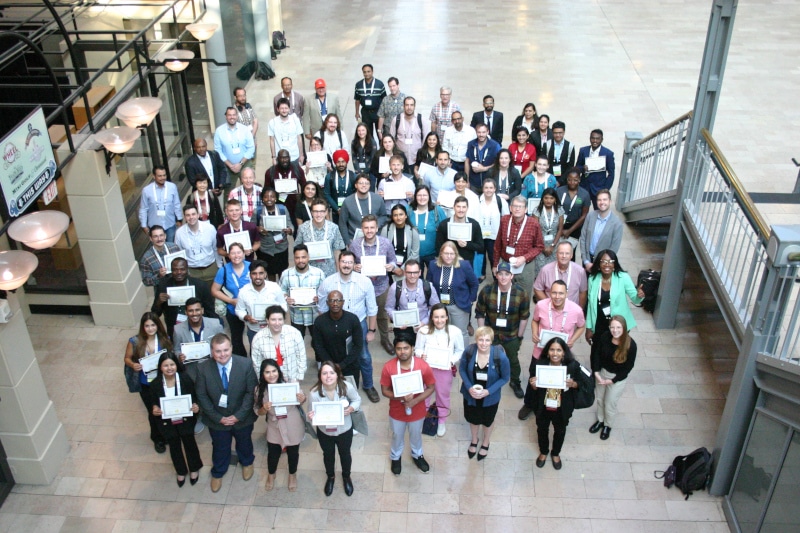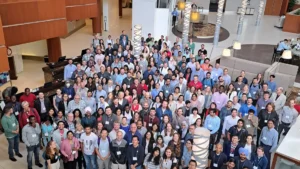The corn breeding world has changed immensely over the past century.
It was in the early 1900s that George Harrison Shull first presented the idea that corn could be improved by developing inbred lines, making and then testing crosses to determine which had the best yield, selecting the best crosses, then providing the seed to farmers. Known as the pure-line method of corn breeding, it was a revolution in plant breeding.
Fast-forward to today and you’ll find researchers at the Iowa State University Agronomy Farm experimenting with a robot that collects images and 3D structural data on maize plant architecture as it moves through the field.
Nitrate sensors taped to the leaves of corn plants continuously collect real-time data on transpiration and nitrate concentrations in the maize.
According to the researchers in the lab of Iowa State genetics professor Pat Schnable, in the future they should theoretically be able to measure exactly how much water a specific corn plant is consuming during the season, how many nutrients the plant is taking up, and whether the plant is deficient in water or nutrients.
But that’s not the eventual outcome to which plant breeders are aspiring to. It goes beyond that, as attendees of this year’s National Association of Plant Breeders (NAPB) meeting heard last month. The meeting was held at Iowa State University in Ames from Aug. 8-11.
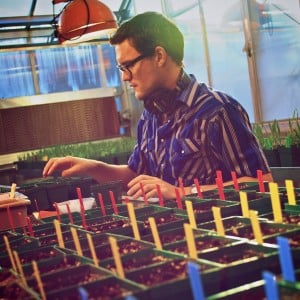
This year’s theme was the past, present and future of plant breeding.
“Plants are like animals in that they can’t get up and move away from hot or cold or walk to food. The idea is, what would happen if we could talk to plants? Imagine asking a plant what it needs, and it comes back and tells you it’s a little low on nitrogen, so you give it more. And, hey, if you could give it some more water, that would be great,” says Duke Pauli, incoming chair of the Plant Breeding Coordinating Committee, which founded the NAPB.
“Today, most crop management tends to be on the reactive side. We see a problem, and we seek to address it. If we can communicate with plants, we kind of shift the paradigm to being more proactive.”
Pauli, a professor in the School of Plant Sciences at the University of Arizona, is part of a team of researchers that has received a $25 million grant to develop a better way to communicate with plants and understand their signals.
As futuristic as it may sound, the project essentially draws on the principles laid out by G. H. Shull back in 1908 — harnessing the power of genetics to create better plant varieties and fuel the seed industry, bringing the past, present and future of plant breeding full circle.
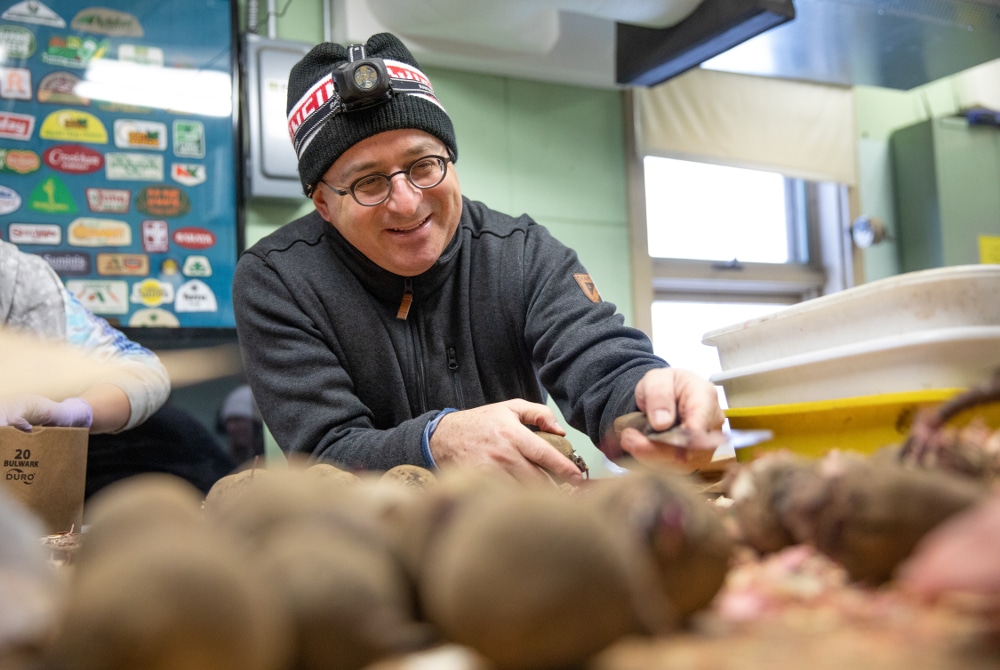
Breeding Innovation on Display
It was the first in-person NAPB meeting since 2019 and nearly 400 plant breeders were brought together, ranging from undergraduate students to established breeders like Irwin Goldman from the University of Wisconsin-Madison, who has worked to develop new table beet varieties to cater to modern tastes.
“The predominant theme for this vegetable is its polarizing nature. Some people love it. Some people love it a lot less. It’s an acquired taste. It’s a vegetable that brings out strong feelings in people,” Goldman says.
Part of this polarizing quality revolves around the volatile organic molecule geosmin. The compound is what creates the “earthy” smell in soil, and it is found in certain foods like beets, spinach and a few others. It is produced by streptomyces bacteria in soil. Humans are very sensitive to geosmin and can detect it at levels of 100 parts per trillion.
Goldman’s own association with beet goes back to his grandparents who came to the United States from eastern Europe. Since then, the beet has taken on a new life thanks to influencers like Martha Stewart and has become a resurgent crop — the number of farms in Wisconsin growing beets more than doubled between 2012 and 2017.
Along with the resurgence came a familiar complaint, Goldman said.
“People would say, ‘Can’t you do anything about the fact they taste like dirt?'”
So, Goldman and his team began working to select away from not only the earthy intensity and the flavour of geosmin, but also away from the astringency associated with oxalic acid contained in beet. Two low-geosmin varieties have arrived on consumers’ dinner plates as a result — Snow Globe (white flesh) and Evansville Ember (red flesh).
Two high-geosmin varieties are available as well.
“Some people enjoy the earthiness in their food, and some really want to stay away from it. We’ve made these cultivars for both groups of people. It’s interesting to see this new market class in the retail space both in the grocery store and in restaurants.”
It was just one example of the innovation on display at this year’s NAPB meeting, being ushered in by a new generation of both plant breeders and businesspeople who have an eye on the future.
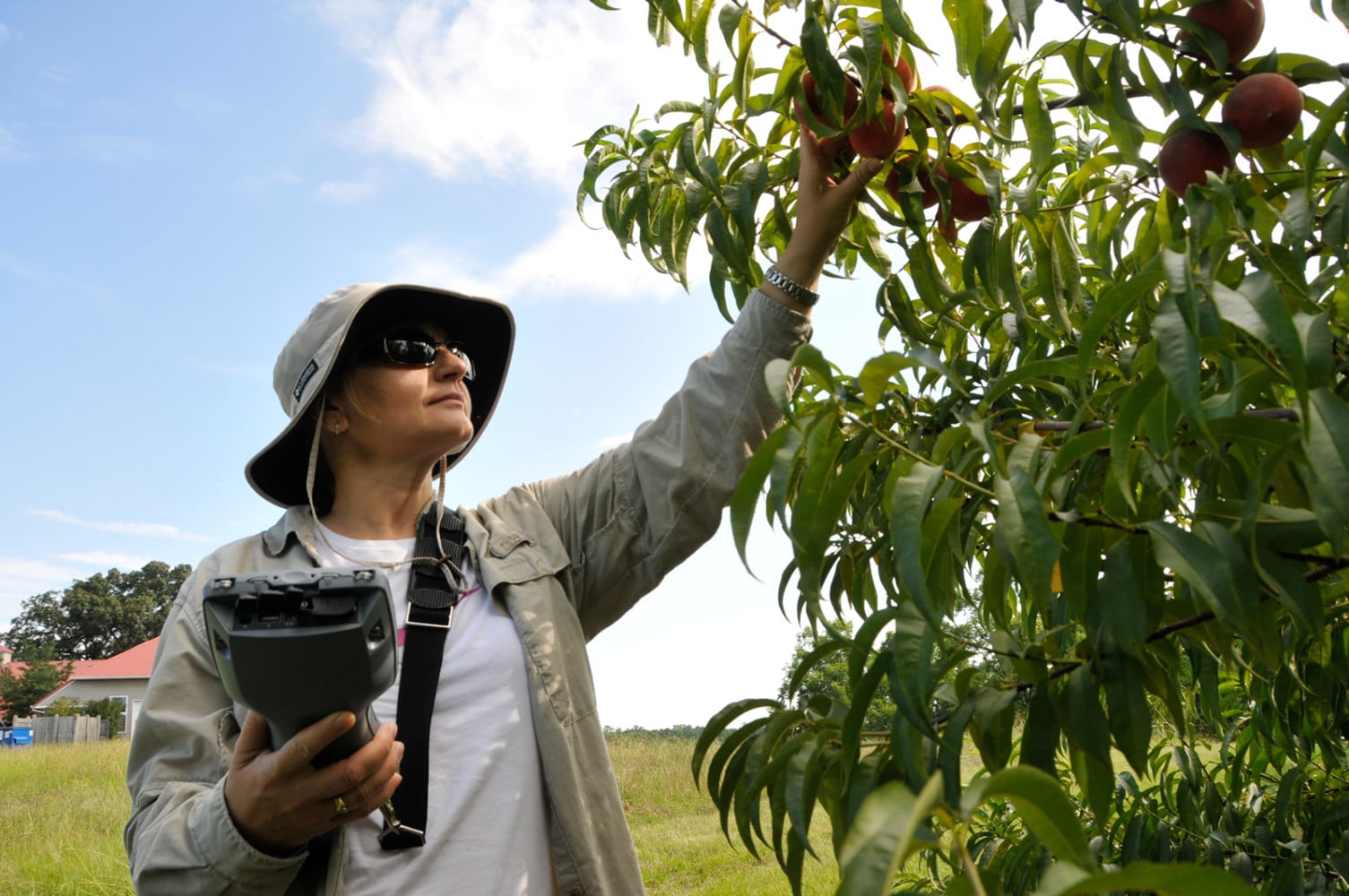
Record Membership
That forward-thinking approach toward the NAPB’s expanding appeal can be seen on the NAPB board as well. Incoming NAPB president Hannah Senior is not a plant breeder. She leads Pollinator Bag Specialists (PBS) International based in the United Kingdom. The company uses fabric technology in pollination control, manufacturing a range of products for plant breeders and seed producers.
She’s also the first NAPB president from outside North America.
“It’s really exciting that we’ve got a record level of membership. We surpassed our goal of reaching 500 or more members by this year and now have over 600. I think what NAPB brings is a combination of things. Number one, the connecting of plant breeders across multiple crops and multiple geographies. There’s also communicating what plant breeding is about,” she said.
“The third thing that NAPB brings is this huge energy around the student community and encouraging more people who are going through their education to think about plant breeding as a career path and understand what that might look like and get involved.”
The almost 400 people who attended this year’s meeting represents over half the NAPB’s membership. Organizers Thomas Lubberstedt and Paul Scott had to cap registrations due to overwhelming demand, showing that members want to return to in-person meetings after a pandemic that raised questions about the viability of in-person events in a post-pandemic world.
“We were worried if we were going to get 300 people like we had in Georgia in 2019,” said Ksenija Gasic, outgoing NAPB president and peach breeder at Clemson University.
“Being a volunteer-based association, it shows you the commitment of our newest members and long-time ones.”
Those new members include a variety of scholarship winners who comprised this year’s Borlaug Scholars (which supports attendance of future leaders at the NAPB annual meeting) and George Washington Carver Scholars (designed to advance access, equity, justice, and inclusion, and to enhance the diversity of the graduate student population).
Encouraging Diversity

The NAPB has always welcomed new blood into its organization with programs like the Borlaug Scholarship. The George Washington Carver Scholarship was formerly known as the Diversity Scholars program. This year, 23 undergraduate and graduate students attended the meeting as Borlaug Scholars, while six attended as Carver scholars.
The Carver program provides an opportunity for plant breeding students belonging to underrepresented groups in the U.S. to attend the meeting along with a mentor in the program.
It’s an excellent program for plant breeding students for equal representation in the plant breeding community, says University of Florida grad student Gurleen Kaur, herself a Borlaug Scholar and chair of the Carver scholarship program.
Of course, welcoming breeders from all walks of life into the NAPB fold is something the organization has always excelled at. Edgar Sierra Orozco hails from Mexico where for seven years he worked as a pest and disease manager at a farm that produced mainly bell pepper, a relative of the tomato. He attended the meeting this year as a Borlaug Scholar.
“At first, I didn’t really think about pursuing a graduate degree. I thought I was mostly fine in terms of my job. Sometime later when circumstances around my job changed, I thought, ‘OK, I guess I need to go learn more than what I know right now,”’ he said.
Now a PhD student in the horticultural sciences department of the University of Florida, his project includes screening and mapping of resistance to target spot of tomato from several wild tomato species to ultimately provide the first-ever target spot resistant tomato varieties.
With Mexico being the largest exporter of tomatoes worldwide, it was a vegetable he gravitated toward.
“Helping growers back in Mexico is a major motivation that makes me want to learn more,” he added.
His work could have a major influence on the tomato world, with the resulting genetics being in high demand around the world and forever changing tomato as a crop.
Iowa State PhD candidate Clayton Carley, himself an NAPB Borlaug Scholar in 2020, hopes to have a similar influence on soybean germplasm by exploring soybean root nodules. His project won this year’s poster competition and explores six diverse soybean genotypes across three field year combinations in three early vegetative stages of development.
His team’s work has unveiled unique relationships between soybean nodules in the taproot and non-taproot growth zones. It could ultimately change nitrogen and protein quantity in soybean seed to result in more efficient plants.
Ensuring Access to Germplasm
Providing germplasm to breeders was a major topic tackled during a talk given by Patrick Byrne, a professor in the Department of Soil and Crop Sciences at Colorado State University.
The U.S. National Germplasm System has around 600,000 accessions across all species of crops and their relatives. It distributes germplasm to researchers around the world free of charge.
Through an online portal known as the Germplasm Resources Information Network (GRIN), breeders can access a database that lists all of the accessions and they can search by species, variety name, and plant introduction (PI) number. It has a Canadian offshoot, GRIN-Global-CA.
Improvements are continually being made, including improving the availability of phenotypic data to make it easier for a breeder to find seeds of interest.
“Plant breeders realize and appreciate the importance of having access to an extensive set of germplasm for their breeding needs. Everyone is faced with new objectives in their program, be it for a new disease or insect or looking for novel nutritional traits, or simply to improve yield and resilience,” Byrne said.
“These days, most people include heat and drought tolerance among their objectives, and some of the materials in the public germplasm system are potentially very excellent for that, especially some of the wild relatives of crop plants.”
Byrne is part of an information campaign (found at grin-u.org) to raise awareness of the system and ensure it’s used to its maximum potential.
“For example, on my campus at Colorado State University, we have the USDA’s largest backup collection of seeds. It’s really a gold mine, but it’s often so under the radar that many people¬† — students and even staff who work there — don’t realize the facility is there.”


